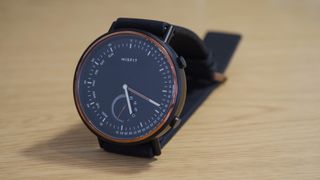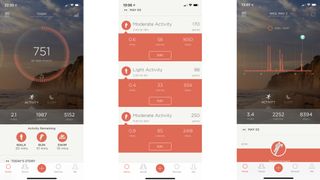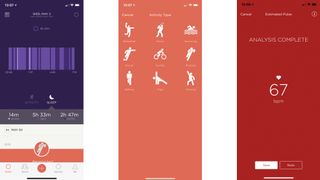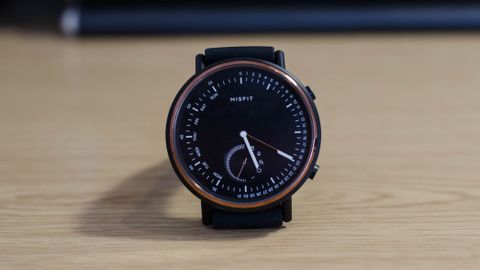Why you can trust TechRadar
Fitness and sleep tracking
- Automatic sleep and fitness tracking
- Manually logged activities don't count towards daily goal
- Water-resistant but no heart rate monitor
The Misfit Command uses three accelerometers to automatically track and log your daily activity and sleep. When first setting up the watch and logging into the Misfit app, you need to give it your date of birth, height and weight, and say whether you are male or female.
Giving your occupation is an option, bizarrely, and the app then spits out a fun fact - like how we burn 1,461 calories a day, which is the equivalent of four avocados. Okay, sure. Whatever you say, Misfit!
By default, the app (and the secondary dial on the watch face itself) count upwards towards a daily goal of 1,000 points. The app suggests this can be achieved by walking for 90 minutes, running for 30 minutes, or swimming for 45 minutes.
We hit the target with about 40 minutes of walking spread throughout the day, but at a pace which caused the app to log it as ‘moderate activity’.

As is often the case with hybrid smartwatches and their apps, your mileage will vary and the data produced shouldn’t be taken as gospel. It’s a useful indication of activity, not a dedicated fitness tracker - a point emphasized by the lack of a heart rate monitor.
For each piece of meaningful movement in a day (shuffling to the fridge doesn’t count), the app logs your steps and distance covered, and estimates how many calories you have burned. Reach your daily target, and the app congratulates you with a notification.
You can also set the Misfit Command to buzz your wrist (and wave its hour and minute arms as if guiding a plane towards the terminal) if you have been inactive for an hour.
We understand the message here, and sometimes it’s useful to be told to get up and walk around, but there’s a distinct lack of intelligence. The watch reminded us three times to get active while we were on a three-hour car journey.
Beyond just counting steps, the Misfit Command and its companion app attempt to identify what you were doing during the day. However, instead of identifying ‘walking’ and ‘running’, the app logs ‘light’, ‘moderate’ and ‘vigorous’ activity.
For each of these, the app shows your steps, distance, time duration and calories burned. You can then edit each of these to say specifically what you were doing - cycling, basketball, football, tennis, running and swimming are the options - and adjust the duration if this wasn’t logged accurately.
Editing these affects your score for that day (not that we would suggest you cheat), but you can’t add entire new events for past days, such as exercise done without the watch. Also, we found that activities added manually to the current day appear in your time log, but don’t affect your score for the day.

The Misfit Command is water-resistant to a depth of 50 meters, which means swimming with it is no problem.
Any swimming you do can be manually added to the app like other activities, but through a partnership with Speedo you can pay to upgrade the Misfit app, adding swimming pool lap counting; just tell the app how long the pool is, and the watch works out the rest.
At $9.99 / £9.99 / AU$14.99, it’s a tall price to pay for adding a fairly simple function, but keen swimmers might be swayed to part with their cash.
The other half of the Misfit app is sleep tracking, which also uses the Command’s accelerometers. You first tell the app how much sleep you’d like each night - eight hours is the norm - and after a night with the Command on your wrist, the app shows how you got along.
Sleep is split into ‘awake’, ‘light’ and ‘restful’, with each assigned a color and plotted against time in a simple graph. This, and other aspects of the Misfit app, will be familiar to owners of any Fossil hybrid smartwatch, such as the Fossil Q Commuter, as Fossil acquired Misfit back in 2015 and the underlying tech is similar across the group’s devices.
It’s always difficult to say with absolute certainty whether sleep data is accurate or not, but on our first night with the Misfit Command we noticed a brief period of being awake at 4am (awake enough to check the time and remember it) was missing from the app log.

Unfortunately, the discomfort we mentioned with the quick-release buckle meant sleeping with the Command was far from ideal. After a couple of nights, we decided we’d sleep better without the watch.
This meant we’d also miss out on the watch’s silent alarm, which quietly vibrates your wrist to wake you and not your partner, but we’d rather opt for a comfier night’s sleep and a blaring alarm than the Command’s discomfort.
Also, you’ll want to remember to switch the alarm off for the nights you choose not to wear the Command, as it vibrates loudly against hard surfaces like your bedside table.

Battery life
- Misfit claims the battery lasts a year
- Case can be easily opened with a coin
As with hybrid smartwatches from other brands of the Fossil group, the Misfit Command is claimed to last a year before it needs a new battery. The watch takes a CR2430 battery, which can be bought online for under $2 / £2 / AU$3.
That year-long claim will vary based on how much you use the watch, of course, so if it is constantly buzzing with notifications then you might see less than 12 months from each battery.
Interface and app
- Simple to get up and running
- Several options for tailoring notifications and watch button
As with most hybrid smartwatches, setting up the Misfit Command takes almost no time. The watch connected quickly to our iPhone via Bluetooth, and the app then guided us through how the watch works, and how to get the most out of it. The time and date are automatically copied over from your phone, and the watch starts tracking your movement right away.
The Misfit Command works with iPhones running iOS 8.2 and newer, and with Android devices running version 4.4 and newer.
Activity tracking, as covered above, is what the Misfit app is all about. However, it is worth diving into the settings to better understand how the notification system works.

Here, you can set the watch to point at a specific hour depending on who is calling or texting you. For example, you could assign your partner to 12 o’clock and your boss to 6 o’clock.
That way, when your phone buzzes with a call or a text message you can see if it is one of those people with a quick glance at your wrist. You could of course assign 12 people, but good luck remembering which hour corresponds to which person.
As well as calls and texts, you can assign certain apps to an hour; for example, Instagram could be 3 o’clock and WhatsApp 9 o’clock. But this will mean a notification buzzing your wrist every time those apps want your attention; there is no way to only get WhatsApp notifications from a specific contact or group chat, so we think this could quickly become a nuisance.

The settings pages are also where you decide what the watch’s lower button does. Pick the music category, and one press is for play/pause, two presses skips to the next song, three skips back and a long press increases the volume.
Selfie mode takes a photo with your phone’s camera with one press or shoots a burst of images if you press and hold.
There’s also a mode for pairing with your computer over Bluetooth and using the watch as a presentation clicker, and there’s an option to customize what the button does - although beyond what we’ve just mentioned, your options are quite limited. We reckon music playback makes the most sense, and is the function we used most often.
Current page: Fitness, battery life, interface and app
Prev Page Introduction, price and design Next Page VerdictAlistair Charlton is a freelance technology and automotive journalist based in London. His career began with a stint of work experience at TechRadar back in 2010, before gaining a journalism degree and working in the industry ever since. A lifelong car and tech enthusiast, Alistair writes for a wide range of publications across the consumer technology and automotive sectors. As well as reviewing dash cams for TechRadar, he also has bylines at Wired, T3, Forbes, Stuff, The Independent, SlashGear and Grand Designs Magazine, among others.


